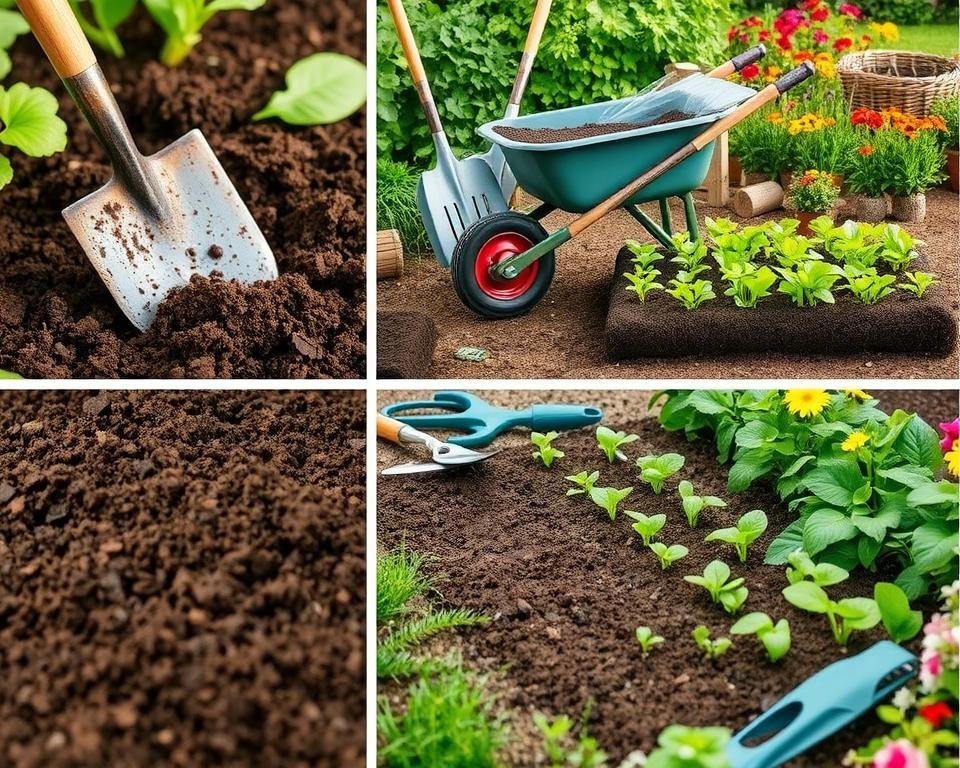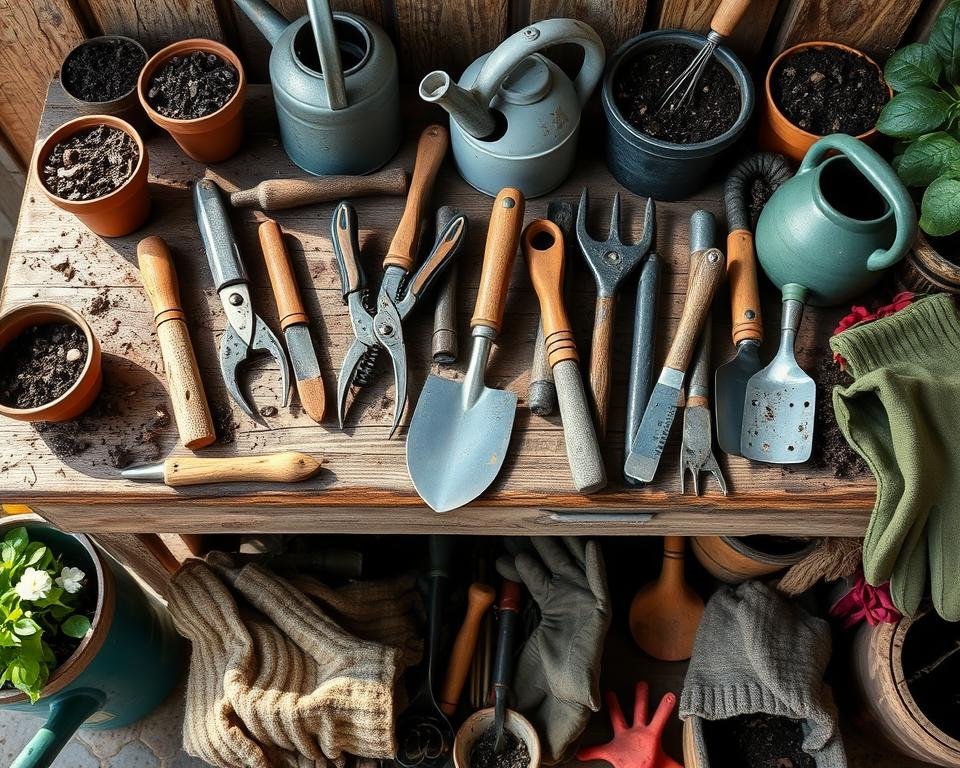Ever wondered what makes a garden grow well? The answer is simple: it’s the soil. In this guide, we’ll show you how to prepare the soil. This will help you grow a garden that’s full of life and color.
Soil preparation is key to a successful garden. It’s what makes your veggies grow strong, your flowers bloom, and your lawn green. We’ll teach you how to improve your soil. This will unlock your land’s full potential.
Understanding Soil: The Foundation of Growth
Soil is key for all plants to grow. Knowing about soil types, pH, and nutrients helps gardeners make the best environment for their plants.
Soil Composition and Types
Soil is made up of minerals, organic matter, air, and water. The mix of these determines soil texture and quality. There are different soil types like sandy, clay, silt, and loam, each with its own benefits.
| Soil Type | Characteristics | Suitable Plants |
|---|---|---|
| Sandy | Coarse, well-draining, low in nutrients | Cacti, succulents, drought-tolerant plants |
| Clay | Dense, slow-draining, high in nutrients | Vegetables, herbs, flowering plants |
| Silt | Fine-textured, moderately fertile, well-draining | Flowers, shrubs, trees |
| Loam | Balanced mixture of sand, silt, and clay, ideal for plant growth | Most vegetables, fruits, and ornamental plants |
Importance of Soil pH and Nutrient Balance
Soil pH is very important for plant health. It affects how plants get the nutrients they need. Most plants do best in a slightly acidic to neutral soil pH, between 6.0 and 7.0. Having the right balance of nutrients like nitrogen, phosphorus, and potassium helps plants grow strong and healthy.
The Art of Soil Preparation
Preparing the soil is key to a great growing spot for your plants. This part talks about how to make your soil perfect for your plants to grow well.
Tilling and Aeration
Tilling the soil is a must-do first step. It makes the soil loose, lets in air, and mixes in organic stuff and additives. It also breaks up hard spots in the soil, helping roots grow and water get in.
Soil Amendments and Texture
Adding organic stuff like compost, peat moss, or rotted leaves makes the soil better. These help the soil hold water, get nutrients, and stay healthy. Working on the soil’s texture also helps plants grow better.
| Soil Preparation Technique | Benefits |
|---|---|
| Tilling | Loosens compacted soil, improves aeration, incorporates amendments |
| Soil Amendments | Improves soil texture, structure, water-holding capacity, and nutrient content |
| Improving Soil Texture | Enhances plant growth and health |
Using these soil prep methods, gardeners and growers can make a rich, healthy soil base. The art of soil prep is vital for a good growing season.

Essential Tools for Soil Preparation
Starting a garden right means having the right tools for soil prep. You’ll need shovels, rakes, tillers, and composting bins. These tools make the job easier and help your garden grow well.
Shovels, Rakes, and Tillers
A good shovel is key for any gardener. It helps dig, mix, and aerate the soil. Rakes are great for leveling and removing debris. For hard soil, a tiller is a must. It makes quick work of breaking up the earth.
Wheelbarrows and Composting Bins
Carrying soil and heavy stuff can be hard work. That’s why a wheelbarrow is so useful. It makes moving compost and soil easy. A compost bin is also essential. It turns waste into soil that feeds your plants.
With the right tools, you can make your garden’s soil perfect for plants. Shovels, rakes, tillers, and bins are all important for soil prep.

Organic Soil Amendments and Compost
Adding organic amendments and compost to your soil is key to a healthy garden. These materials boost soil fertility and health. They help plants grow strong and well.
Composting Techniques
Composting turns waste into a soil booster. It’s all about managing the breakdown process. Gardeners need to pick the right stuff, keep it moist, and aerated.
Incorporating Organic Matter
When compost is ready, add it to your soil. Spread it over the bed and mix it in. This makes the soil better at holding water and nutrients.
| Organic Soil Amendment | Benefits |
|---|---|
| Compost | Improves soil structure, increases nutrient availability, and enhances water-holding capacity. |
| Peat Moss | Increases soil acidity, improves water retention, and provides a boost of organic matter. |
| Manure | Adds essential nutrients, improves soil texture, and supports microbial activity. |
| Leaf Litter | Provides a slow-release source of organic matter and nutrients as it decomposes. |
Soil Testing and Nutrient Management
Healthy, nutrient-rich soil is key for thriving plants and a successful garden. Soil testing helps understand your soil’s needs. It lets you plan how to feed your plants well.
Understanding Soil Test Results
Soil test results show the pH and nutrients like nitrogen, phosphorus, and potassium. They also show micronutrients like iron and calcium. This info helps you fix any nutrient problems and choose the right soil amendments.
Developing a Nutrient Management Plan
With your soil test results, you can make a plan for your garden or farm. This plan might include adding compost or manure to improve soil. It could also involve using specific fertilizers to keep the soil balanced.
| Nutrient | Ideal Range | Recommended Application |
|---|---|---|
| Nitrogen (N) | 30-60 ppm | Organic nitrogen sources (e.g., compost, blood meal) |
| Phosphorus (P) | 20-40 ppm | Bone meal, rock phosphate |
| Potassium (K) | 150-300 ppm | Greensand, wood ash |
By sticking to a good nutrient plan, your plants will get what they need. This also helps keep your soil healthy for the long term.
Conclusion
Learning how to prepare soil is key to a successful garden or farm. It’s about knowing your soil, using the right tools, and adding organic stuff. This way, you can make your land produce lots of strong, healthy plants.
This guide has given you all you need to know. It shows how to make your soil rich and full of life. This will help you grow your garden or farm just the way you want.
If you love gardening or are just starting, this info will help you a lot. It teaches you how to make your garden or farm a place of beauty and growth. By using green methods, you’ll grow plants that are not only healthy but also strong.
Be proud of your work in making your soil better. Keep learning and trying new things to make your land even better. With hard work and love for nature, you can turn your outdoor space into a beautiful, green haven.
FAQ
What is the importance of soil preparation for gardening and farming?
Soil preparation is key for a healthy garden or farm. It gives plants the nutrients, moisture, and structure they need. Knowing your soil’s needs helps create the best growing conditions for your crops.
What are the key steps in the soil preparation process?
The main steps include testing the soil, adding organic amendments, and tilling. You also need to balance the pH and nutrient levels. These steps help plants grow strong and healthy.
How do I know if my soil needs improvements?
Testing your soil regularly is the best way to know its condition. A soil test shows the pH, nutrient levels, and composition. This information helps you make the right improvements.
What are the best organic soil amendments to use?
Top organic amendments are compost, aged manure, peat moss, and rock powders. They add nutrients, improve texture, and support microorganisms. These help your soil and plants thrive.
How do I create my own compost for soil enrichment?
Composting turns kitchen scraps and yard waste into nutrient-rich soil. Keep a mix of brown and green materials, with moisture and air. This way, you can make great compost for your garden.
What tools are essential for effective soil preparation?
You’ll need shovels, rakes, tillers, hoes, and wheelbarrows. These tools help till, mix in amendments, aerate, and move materials. Good tools make soil preparation easier and more effective.
How do I maintain healthy soil long-term?
Keeping soil healthy takes ongoing effort. Regular testing, applying organic amendments, and crop rotation are key. Also, use sustainable practices like mulching and cover cropping. This approach keeps your soil fertile and productive for years.

